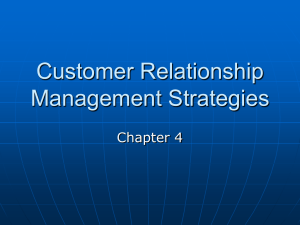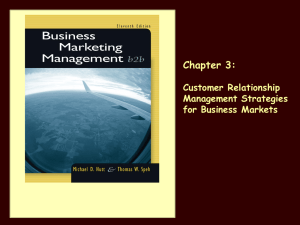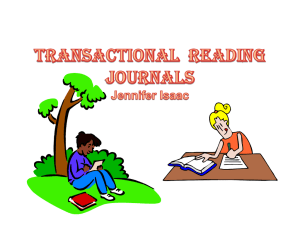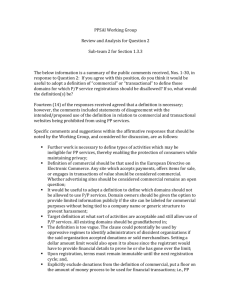Customer Relationship Management Strategies for Business Markets
advertisement
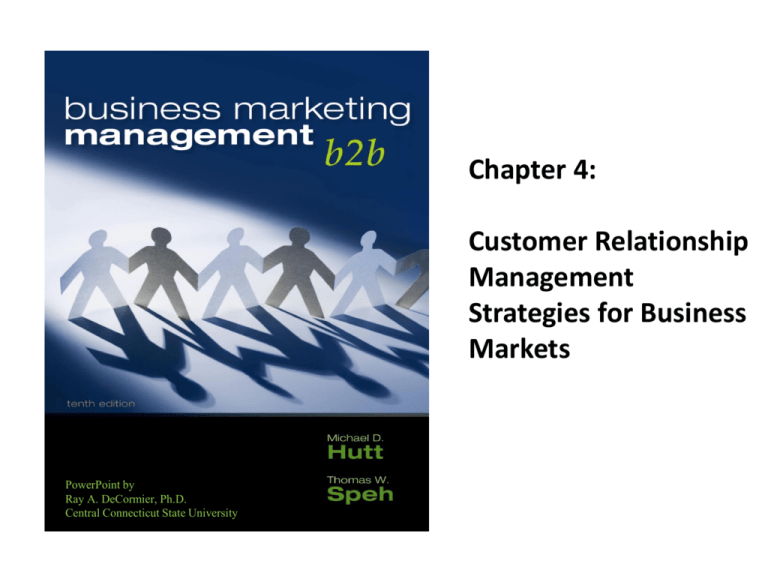
Chapter 4: Customer Relationship Management Strategies for Business Markets PowerPoint by Ray A. DeCormier, Ph.D. Central Connecticut State University Chapter Topics Well developed relationships give business marketers a significant competitive advantage. Topics include: 1. Patterns of buyer-seller relationships 2. Factors that influence customer profitability 3. Strategies for designing effective customer relationships 4. How successful firms excel at customer relationship management 5. Critical determinants for managing strategic alliances Collaborative Advantage • Relationship Marketing centers on establishing, Developing, and maintaining successful exchanges with customers • New era of business marketing is dependent upon managing relationships. • Collaborative advantage is: – Demonstrating special skills with “key” customers or – Developing innovative strategies with alliance partners Types of Relationships • Continuum of buyer-seller relationships • Transactional, Value-added & Collaborative exchanges The Relationship Spectrum Transactional Exchange • Centers on timely exchange of basic products at highly competitive market prices • These types of transactions are autonomous, meaning that there is little or no concern as to the needs of buyer or seller • Example: A person comes into a store and buys a hammer. The buyer wants a hammer and the seller sells him one. That’s all there is to it! • The business market includes items like: – Packaging, – Cleaning products or – Commodity-type products or service activity where bidding is employed. Transactional exchanges employ an Arms-Length relationship. Collaborative Exchange Occurs when alternatives are few, market is dynamic, the purchase is complex and the price is high Features close information, social, and operational linkages, as well as mutual commitments Switching costs are extremely important to collaborative customers Trust is the key and it exists when one party has complete confidence in their partner’s ability and integrity This strategy emphasizes joint-problem solving and multiple linkages such as R&D and manufacturing. Value-Added Exchanges • Value-Added Exchanges fall between Transactional and Collaborative Exchanges • The selling firms shifts from just attracting customers to keeping them by: 1. Adding additional services 2. Developing services that are customized to meet the buyer’s needs 3. Providing continuing incentives that promote repeat business Spectrum of Buyer-Seller Relationships Buyers and sellers craft various relationships in response to: a) Market conditions b) Characteristics of the purchase situation Switching Costs • A major consideration before changing suppliers • Buyers invest heavily in supplier relationships – Training, documentation, integration, process modifications – hiring specialized skill sets – contracting, publicity • Switching can cause costly disruptions. • Moving to less-established suppliers can be risky • The prospect’s PROBLEM must exceed the BENEFITS experiencing with current supplier before considering switching. Good marketers seek to establish high switching costs through value-added services Characteristics of Business Market Customers Table 4.1 Value Drivers in Key Supplier Relationships Sources of Value Creation Relationship Value Dimensions Costs Benefits __________________________________________________________________ Core offering Product quality Direct cost Delivery performance Sourcing process Customer operations Service support Personal interaction Supplier know-how Time to market Acquisition costs Operation costs _________________________________________________________________________ SOURCE: Wolfgang Ulaga and Andreas Eggert, “Value-Based Differentiation in Business Relationships: Gaining and Sustaining Key Supplier Status,” Journal of Marketing 70 (January 2006): p. 122. Furthering Collaborative Relationships Obtain ‘key supplier’ status by… • Target the right customer. • Match with their purchasing situation. • Develop strategies that are appropriate for each type of buyer – Offer specialized services and customized products • Competence and commitment are vital to reducing buyer’s initial perceived risk Good marketers know their key customers’ business model intimately Measuring Customer Profitability • Activity-based costing (ABC) - allocates cost of performing various services to each customer (customer-specific costing). • Through Customer Relations Management (CRM) programs, one can relate revenues and costs to each and every activity. • By linking financial information with transactional data created in CRM programs, companies are able to accurately calculate “cost-to-service” components to yield customer profitability. Differentiation & customization are costly – must always revisit ROI assumptions Figure 4.3 The Whale Curve of Cumulative Profitability Whale Curve & Profitability • 20/80 Rule says “20% of customer provide 80% of sales • Whale Curve reveals: – – – – 20% of customers generate 150–300% of total profits 70% of customers break even 10% of customers lose from 50-200% of total profits Leaving company with 100% of total profits Characteristics of High Cost-to-Serve Customers Order custom products Order small quantities Unpredictable order arrivals Customized delivery Frequent changes in delivery requirements Manual processing Large amounts of support – • Pre-sales - marketing, technical, and sales resources) • Post sales - installation, training, warranty, field service) Require company to hold inventory Pay slowly (i.e., high accounts receivable) Source: Robert S. Kaplan and V.G. Narayanan, “p. 8. Measuring and Managing Customer Profitability,” Journal of Cost Management 15, No. 5 (September/October 2001): Customer Profitably As mentioned previously, some customers are profitable and some aren’t. To determine this, we look at the cost/profitability structure with the plan to: 1. Keep profitable customers w/proactive retention strategies 2. Convert unprofitable ones to profitability 3. Fire those who are not profitable Customer Profitability Net Margin Realized High Passive Product is crucial Good supplier match Costly to service, but pay top dollar Price-sensitive but few special demands Aggressive Leverage their buying power Low price and lots of customization Most challenging Low Low High Cost-to-Serve SOURCE: From “Manage Customers for Profits (Not Just Sales)” by B.P. Shapiro et al., September-October 1987, p. 104, Harvard Business Review. Customer Relationship Management Customer Relationship Management (CRM) is a cross-functional process for achieving… a. Continuing dialog with customers across all contact and access points b. Personalized service to the most valuable customers c. Increased customer retention through continuous feedback d. Improved marketing effectiveness through superior customer insight CRM Technology • CRM programs are software systems that capture information and integrate sales, marketing and customer service information. • CRM programs can gather information from many sources including email, call centers, service and sales reps. • The information is available to the right people in the organization in real time. – Everyone has the same 360 degree view of a customer CRM Strategy - Priorities 1. Acquire the right customer 2. Craft the right value proposition 3. Institute the best processes 4. Motivate employees 5. Learn to retain customers Figure 4.5 - Transactional & Collaborative Working Relationships Pure Transactional Exchange (a) Industry Relationship Bandwidths Pure Collaborative Exchange Medical Equipment (e.g. imaging systems) Hospital Supplies (e.g. surgical gloves, syringes) (b) “Flaring Out” from the Industry Bandwidth Pure Transactional Exchange Pure Collaborative Exchange Hospital Supplies A B C D SOURCE: Adapted from James C. Anderson and James A. Narus, “Partnering as a Focused Marketing Strategy,” California Management Review 33 (spring 1991)’ p. 97. Copyright © by the Regents of the University of California. Reprinted by permission of the Regents. Flaring Out Strategy • ‘Flaring out’ strategy (Fig 4.5b) states that the seller can either unbundle (point A), that is, reduce the service associated with a lower price (transactional in nature), or • Augment by adding more services to the core offerings (point D) which adds cost to the services. This is collaborative in nature. Creating Customized Products The seller starts with a core service (“naked solutions”) and adds customized services to it (“custom wrapped”) that create more value. #3 - Institute Best Practices • The sales force plays a key role in establishing and growing a customer from a transactional account to a collaborative partnership. • They can do this by aligning and deploying technical and service support units to match with their customers’ units. • Technical groups can consist of research, logistics and customer service units. • Through careful management and screening, transactional accounts can progress to partnerships. Best Practices Follow-Up • In addition to using best practices, successful organizations (like IBM) employ follow-up techniques such as: 1. Assigning a client representative to take ownership of the relationship. 2. Assigning a Project Owner who completes the project or solves project problems. 3. Developing an in-process feedback and measurement system. #4 - Motivating Employees Dedicated employees are the key to a successful customer relationship strategy. The best approach is to: 1. Hire good people. 2. Invest in them to increase their value to the company and its customers. 3. Develop challenging careers and align incentives to performance measures. Why Retain Loyal Customers? Established customers buy more. Cost of serving loyal customers declines. Less expensive than acquiring new customers. How to Pursue Growth from Existing Customers Identify and cultivate customers that offer the most growth potential by: 1.Estimating current percent “share of wallet” 2.Pursuing opportunities to increase share 3.Projecting and enhancing customer profitability Strategic Alliances vs. Joint Ventures • Strategic alliances involve a “formal long-run linkage, funded with direct co-investments by two or more companies, that pool complementary capabilities and resources to achieve generally agreed objectives.” • Joint Ventures involve the formation of a separate independent organization by venture partners. Benefits of a Strategic Alliance 1. 2. 3. 4. Access to new markets Access to new technologies Economies of scale Faster entry of new products into markets due to established distribution channels 5. Sharing costs and risks Elements of Successful Alliances Start with a strategy map detailing each partners goals and contributions. 1. What does JV offer the customer? 2. Aligned around common goals? 3. Are unique customer benefits jointly agreed to? • • • Agree on each partner’s contribution to alliance Select good communicators to convey alliance’s strategic role and create its “identity” Establish direct ties at top levels to engender organizational commitment. – Combats inevitable post-honeymoon cynicism Social Connections in an Alliance Figure 4.7 Social Connections in an Alliance Alpha 22 Omega 17 2 3 5 34 38 20 14 35 26 25 36 7 16 8 24 4 23 12 9 31 11 19 42 21 27 39 37 29 15 Peripheral Participants Strong Linkages Across Firms Strong Linkages Within Firms Most Senior Executive Project Manager 33 Boundary Spanners 41 40 13 Core Participants 30 6 10 1 28 18 32 Peripheral Participants Five Levels of Integration Strategic Senior executives continuously define and communicate broad goals or changes in each company Tactical Middle managers plan joint ventures, transfer knowledge and work to improve inter-firm connections Operational Concerned with providing information, resources and personnel to carry out daily work Interpersonal Facilitate an environment for people to know each other, learn together and create new value Cultural Managers are required to have communications skills and be culturally aware to bridge differences
